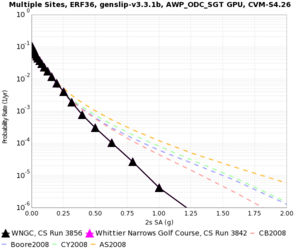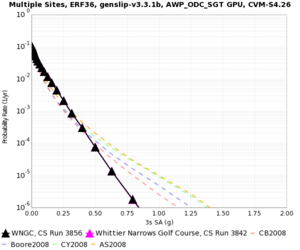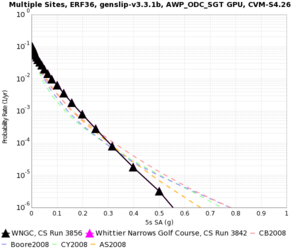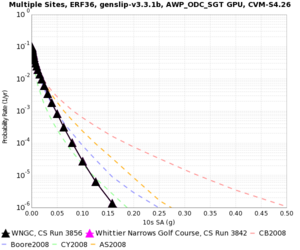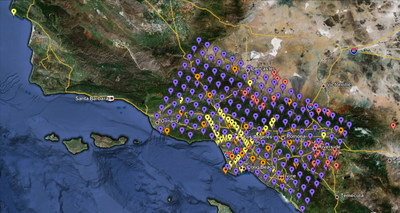CyberShake Study 15.4
CyberShake Study 15.3 is a computational study to calculate one physics-based probabilistic seismic hazard model for Southern California at 1 Hz, using CVM-S4.26, the GPU implementation of AWP-ODC-SGT, the Graves and Pitarka (2015) rupture variations with uniform hypocenters, and the UCERF2 ERF. The SGT calculations will be split between NCSA Blue Waters and OLCF Titan, and the post-processing will be done entirely on Blue Waters. The goal is to calculate the standard Southern California site list (286 sites) used in previous CyberShake studies so we can produce comparison curves and maps, and data products for the UGMS Committee.
Contents
Preparation for production runs
Check list of Mayssa's concernsUpdate DAX to support separate MD5 sumsAdd MD5 sum job to TCEvaluate topology-aware schedulingGet DirectSynth working at full run scale, verify resultsModify workflow to have md5sums be in parallelTest of 1 Hz simulation with 2 Hz source - 2/27Add a third pilot job type to Titan pilots - 2/27- Run test of full 1 Hz SGT workflow on Blue Waters - 3/4
- Add cleanup to workflow and test - 3/4
Test interface between Titan workflows and Blue Waters workflows - 3/4Add capability to have files on Blue Waters correctly striped - 3/6Add restart capability to DirectSynth - 3/6File ticket for extended walltime for small jobs on Titan - 3/6Add DirectSynth to workflow tools - 3/6Implement and test parallel version of reformat_awp - 3/6- Simulate curves for 3 sites with final configuration; compare curves and seismograms - 3/11
- File ticket for 90-day purged space at Blue Waters - 3/13
- File ticket for reservation at Blue Waters, along with justification - 3/13
- Follow up on high priority jobs at Titan - 3/13
- Create study description file for Run Manager - 3/13
- Set up usage monitoring on Blue Waters and Titan
- Add ability to determine if SGTs are being run on Blue Waters or Titan
- Modify auto-submit system to distinguish between full runs and PP runs
- Science readiness review - 3/18
- Technical readiness review - 3/18
Computational Status
We are hoping to begin this study in March 2015.
Data Products
Goals
Science Goals
- Calculate a 1 Hz hazard map of Southern California.
- Produce a contour map at 1 Hz for the UGMS committee.
- Compare the hazard maps at 0.5 Hz and 1 Hz.
Technical Goals
- Show that Titan can be integrated into our CyberShake workflows.
- Demonstrate scalability for 1 Hz calculations.
- Show that we can split the SGT calculations across sites.
Verification
DirectSynth
A comparison of 1 Hz results with SeisPSA to results with DirectSynth for WNGC. SeisPSA results are in magenta, DirectSynth results are in black. They're so close it's difficult to make out the magenta.
| 2s | 3s | 5s | 10s |
|---|---|---|---|
2 Hz source
Source comparisons are available at CyberShake Source Filtering.
Blue Waters vs Titan for SGT calculation
Sites
We are proposing to run 286 sites around Southern California. Those sites include 46 points of interest, 27 precarious rock sites, 23 broadband station locations, 43 20 km gridded sites, and 147 10 km gridded sites. All of them fall within the Southern California box except for Diablo Canyon and Pioneer Town. You can get a CSV file listing the sites here. A KML file listing the sites is available here.
Performance Enhancements (over Study 14.2)
Responses to Study 14.2 Lessons Learned
- AWP_ODC_GPU code, under certain situations, produced incorrect filenames.
This was fixed during the Study 14.2 run.
- Incorrect dependency in DAX generator - NanCheckY was a child of AWP_SGTx.
This was fixed during the Study 14.2 run.
- Try out Pegasus cleanup - accidentally blew away running directory using find, and later accidentally deleted about 400 sets of SGTs.
We have added cleanup to the SGT workflow, since that's where most of the extra data is generated, especially with two copies of the SGTs (the ones generated by AWP-ODC-GPU, and then the reformatted ones).
- 50 connections per IP is too many for hpc-login2 gridftp server; brings it down. Try using a dedicated server next time with more aggregated files.
We have moved our USC gridftp transfer endpoint to hpc-scec.usc.edu, which does very little other than GridFTP transfers.
SGT codes
- We have moved to a parallel version of reformat_awp. With this parallel version, we can reduce the runtime by 65%.
PP codes
- We have switched from using extract_sgt for the SGT extraction and SeisPSA for the seismogram synthesis to DirectSynth, a code which reads in the SGTs across multiple cores and then uses MPI to send them directly to workers, which perform the seismogram synthesis. We anticipate this code will give us an efficiency improvement of at least 50% over the old approach, since it does not require the writing and reading of the extracted SGT files.
Workflow management
- We are using a pilot job daemon on Titan to monitor the shock queue and submit pilot jobs to Titan accordingly.
- The MD5sums calculated on the SGTs at the start of the post-processing now run in parallel with the actual post-processing calculations. If the MD5 sum job fails, the entire workflow will be aborted, but since that is rare, the majority of the time the rest of the post-processing workflow can continue without having the MD5 sums in the critical path.
Codes
Lessons Learned
Computational and Data Estimates
Computational Time
Titan
SGTs (GPU): 1800 node-hrs/site x 143 sites = 258K node-hours = 7.7M SUs
Add 25% margin: 9.6M SUs
Blue Waters
SGTs (GPU): 1300 node-hrs/site x 143 sites = 186K node-hours (3.0M SUs), XK nodes
PP: 2500 node-hrs/site x 286 sites = 715K node-hours (22.9M SUs), XE nodes
Add 25% margin: 1.1M node-hours
Storage Requirements
Titan
Purged space to store SGTs while generating: (1.5 TB SGTs + 120 GB mesh + 1.5 TB reformatted SGTs)/site x 143 sites = 446 TB
Blue Waters
Space to store SGTs (delayed purge): 1.5 TB/site x 286 sites = 429 TB
Purged disk usage: (1.5 TB SGTs + 120 GB mesh + 1.5 TB reformatted SGTs)/site x 143 sites + (27 GB/site seismograms + 0.2 GB/site PSA + 0.2 GB/site RotD) x 286 sites = 453 TB
SCEC
Archival disk usage: 7.5 TB seismograms + 0.1 TB PSA files + 0.1 TB RotD files on scec-04 (has 171 TB free) & 24 GB curves, disaggregations, reports, etc. on scec-00 (171 TB free)
Database usage: (5 rows PSA + 7 rows RotD)/rupture variation x 450K rupture variations/site x 286 sites = 1.5 billion rows x 151 bytes/row = 227 GB (4.3 TB free on focal.usc.edu disk)
Temporary disk usage: 515 GB workflow logs. scec-02 has 171 TB free.
